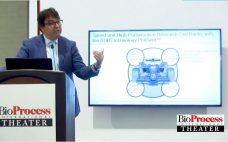Chinese hamster ovary (CHO) cells are the expression system of choice for the manufacturing of biotherapeutics. They have the capacity to express a range of proteins such as therapeutic enzymes or monoclonal antibodies at multiple gram per liter titers. As expression technologies have developed, obtaining such titers has been achieved mainly through improvements to media and feed. Similarly, the ability to identify high-productivity clones has been streamlined through the use of different selection systems, with metabolic selection being the preferred…
Sponsored Content
Purification Control Systems for Every Step of the Development Process
Early stage development of biological unit operations is critical to ensuring an efficient and robust commercially viable process. Often, the types of experiments required in early stage development are arduous tasks that require extensive testing of different critical process parameters, filters, and other essential production components. Such testing inherently produces massive amounts of data that must be carefully analyzed. To streamline the development process and optimize operational efficiency, PendoTECH has developed a full offering of control systems specifically designed for…
Efficient Bioprocess Development with Online Analytics and Data Management
As an engineering company, we are optimizing and developing new technologies for more efficiency in bioprocessing. Building on over 25 years of experience in online analytics, information processing, and automation technology, we aim to be the trusted technology provider for optimized workflows through automated sampling and process information management. Who We Are Securecell emerged in 2009 from the company Biospectra, which was founded as a spin-off from ETH ZĂĽrich in 1992. Ever since, development of online analytic solutions for bioprocess…
Acidic IgM Purification with a New Anion Exchange Resin
IgM antibodies are one of the fastest growing groups of diagnostic and therapeutic candidates. Unlike IgGs, IgMs cannot be purified by affinity chromatography due to their physiochemical properties. The large size of IgMs presents an additional purification challenge. Bio-Rad has developed a new strong anion exchange (AEX) resin — Nuvia HP-Q — to overcome the multiple issues faced when purifying large biomolecules. We show the purification of an acidic IgM antibody with capture purification using Nuvia HP-Q and polish purification…
A Platform Production Process for Manufacturing Viral Vector and Vaccine Therapeutics Using Vero Cells
Yan Zhi, program design technical lead, Fujifilm Diosynth Biotechnologies Fujifilm Diosynth Biotechnologies (FDB) is a world-leading contract development and manufacturing organization (CDMO) with over 25 years of experience using biologicals and more than 310 projects including six licenses. Production sites are located in North Carolina and Texas. In Texas, the flexible biomanufacturing facility can handle production from preclinical to current good manufacturing practices (CGMP) commercial manufacturing. Facilities and capabilities include state-of-the-art process development; mobile cleanroom (MCR) technology with fully segregated…
Manufacturing Automation for Patient-Scale Cell Therapies
Nina Bauer, associate director of autologous cell therapy commercial development, Lonza Pharma and Biotech Lonza Emerging Technologies is focusing on cell and gene therapies. Lonza now has expertise in different cell and vector types, constructs, process and assay development, and platform technologies for both clinical and commercial manufacturing. This includes taking a concept through commercial manufacturing. Lonza just opened a site in Houston, TX, and another in the Netherlands, as well as partnering with Nikon in the Asian market. Cell…
Acoustic Cell Processing: An Innovation in Cell-Therapy Manufacturing
Richard Grant, chief product officer, FloDesign FloDesign is experimenting with applications of acoustics to cell-therapy manufacturing. An electric transducer is attached to a closed-flow system and generates forward propagating waves that are reflected as backward propagating waves. This sets up three-dimensional standing waves within the cell (flow) chamber. When cells enter the flow channel, acoustic forces cause then to cluster within the nodes of those standing waves, ultimately settling out through enhanced gravitational means. Acoustic cell processing is scalable and…
The Development of a Next Generation Antibody–Drug Conjugate (ADC)
Michelle Zengh, chief operating officer, MabPlex International Company Ltd. MabPlex presents a complete solution from gene cloning to antibody–drug conjugate (ADC) fill–finish with a timeline from gene cloning to an investigational new drug application (IND) in 22 months. The company has facilities in San Diego and in China. It can perform cloning and high-yield stable cell-line development, process development and scale-up, CGMP quality and kilogram-scale monoclonal antibody (MAb) and payload manufacturing, large-scale conjugation (150–500 L), large-scale purification, formulation, and fill–finish.…
Rapid, Reliable Response to Biologic Drug Substance and Drug-Product Supply Challenges
Scott Battist, vice president, general manager, and site head for the drug substance plant, Emergent Bio BJ Hull, vice president, general manager, and site head for the drug product plant, Emergent Bio Willfredo Mateo, director of MS&T for the Camden fill–finish plant, Emergent Bio Emergent Bio started by producing treatments for an anthrax emergency. Traditionally, this has been a biodefense company with contracts from the US government. The company is focused on providing specialty products for civilians and military members…
Speed Matters: Gene to GMP in Nine Months
Igor Fisch, chief executive officer, Selexis, SA Fisch first posed this question: “How can we accelerate the number of drugs going into the clinics?” Speed matters because the faster a drug can get into clinical testing, the faster it can make it to market. He discussed both Selexis and KBI Biopharma and their collaboration, which started in 2012 when KBI developed a heterodimer purification process. JSR acquired both companies with an interest in entering the life sciences business. Selexis has…










